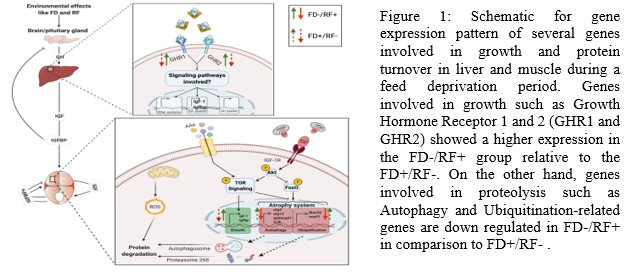THE UNDERLYING MOLECULAR MECHANISM FOR UTILIZING THE SOY PROTEIN DURING COMPENSATORY FEEDING REGIME IN RAINBOW TROUT
Aquaculture Research Institute at University of Idaho in collaboration with USDA has genetically selected the several lines of rainbow trout (Oncorhynchus mykiss) that show higher growth rates when fed all plant protein diet (PPD) than non-selected lines of trout fed a fishmeal-based diet. Aim of the study was to test if feed intake and body weight variations during successive periods of feed deprivation (FD) and re-feeding (RF) are correlated using compensatory feeding regime and has examined the expression of several classes of genes involved in growth, proteolysis and electron transport chain throughout this feeding challenge.
We have used 1600 fish from 12 families of the selected trout lines, fed PPD (50% soy). Fish were tagged individually, reared in common environment, went through the first feeding challenge, alternate months of FD and RF for 4 months, and performance was recorded . Thereafter, fish were separated into four groups (1331 fish) based on individual performance during FD and RF challenge studies. Feed Intake was recorded for 3 months in all four groups followed by measuring the stability of response to the FD and RF periods (second feeding challenge) which was the same as the first one. Muscle and liver samples were collected after each month of the challenge (FD and RF) and gene expression patterns we re studied during the FD and RD periods via qRT -PCR.
The expression pattern of studied genes in a feed depravation and refeeding period is briefly shown in Figure 1. We examined the expression of three major categories of genes s ince weight gain and weight loss variations are correlated with growth, protein turn over and energy consumption in the body. Genes known to be involved in growth are upregulated in the liver and muscle of FD-/RF+ group (best performers) during FD and an opposite pattern is expected during the re-feeding time. However, more details are still under investigation.
Conclusively our study provides the molecular basis for efficient utilization of soy-based diet in trout, and it helps us to move toward the high inclusion of soy protein in salmonids industry.
